
High-resolution images of the stamps are available for media use only by emailing mark.r.saunders@usps.gov.
DALLAS — You don’t need a smartphone to tweet once the Postal Service issues 10 colorful Songbirds Forever Stamps. The dedication ceremony takes place at 10:30 a.m. tomorrow in Dallas at the Trinity River Audubon Center,6500 Great Trinity Forest Way (formerly South Loop 12).
“Songbirds have been singing and delighting humans for thousands of years, so it’s only fitting that today they receive their own postage stamps,” said U.S. Postal Service Southern Area Vice President Jo Ann Feindt, who will dedicate the stamps. “As you celebrate all of the upcoming events of spring — Mother’s Day, Father’s Day, graduations and weddings, or whatever the occasion, remember the Songbirds stamps.”
Illustrator Robert Giusti of Bridgewater, CT, depicted each bird perching on a fence post or branch embellished with vines, pinecones, leaves or flowers. The paintings appear against a plain, white background. Art director Derry Noyes of Washington, DC, designed the stamps.
Customers may purchase the Songbirds Forever Stamps in booklets of 20 at usps.com/stamps, at 800-STAMP-24 (800-782-6724), at Post Offices nationwide or at ebay.com/stamps.
Scheduled to join Feindt in the dedication are Audubon Texas Executive Director Brian Trusty; Trinity River Audubon Center Director of Operations T. Hanson; and, Rogers Wildlife Rehabilitation owner Kathy Rogers.
“Spring migration is turning our skies into a superhighway of migrating birds for the next several weeks, including many of the beautiful species depicted in these stamps,” said Trusty. “We hope everyone who has the opportunity to use these stamps will be reminded of the beauty of nature and the importance of conservation as a part of everyday life.”
Note: Hyperlinks from each bird name listed below link to chirping audio recordings, migration maps, nesting information and photographs from the National Audubon Society’s bird guide.
The stamps depict: the western meadowlark (Sturnella neglecta), the mountain bluebird (Sialia currucoides), the western tanager (Piranga ludoviciana), the painted bunting (Passerina ciris), the Baltimore oriole (Icterus galbula), the evening grosbeak (Coccothraustes vespertinus), the scarlet tanager (Piranga olivacea), the rose-breasted grosbeak (Pheucticus ludovicianus), the American goldfinch (Spinus tristis) and the white-throated sparrow (Zonotrichia albicollis).
Between 4,000 and 4,500 different types of songbirds can be found around the planet, accounting for nearly half of all bird species. Songbirds are identified by their highly developed vocal organs. Some songbirds, like the crow, have harsh voices, others sing rarely or not at all. All songbirds are classified as perching birds. With three toes pointing forward and one pointing backwards, they can grip branches and grasses with ease.
Why do songbirds make such a glorious sound every morning? In a word, love. Males sing to attract females and to warn rivals to keep out of their territory.
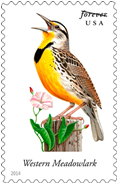
Despite its name, the western meadowlark can be found in midwestern as well as western states, especially in meadows and open fields. Males often serenade the neighborhood from a convenient fence post, and their flute-like songs are as distinctive as their bright yellow breasts, marked with a bold, black “V.” The western meadowlark is the state bird of Kansas, Montana, Nebraska, North Dakota, Oregon and Wyoming; as a state symbol, only the northern cardinal is more popular.
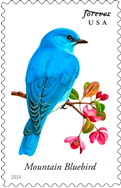
Henry David Thoreau wrote, “The bluebird carries the sky on his back.” But of the three species of bluebirds — eastern, western and mountain — only the male mountain bluebird is almost completely covered with brilliant, sky-blue feathers. Symbolizing happiness, this bluebird is not elusive, being fairly common in western states. Many people give the three species of bluebirds a helping hand by building nest boxes for them, or creating a route of several boxes known as a “bluebird trail.”
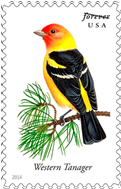
When the male western tanager is ready to breed, he puts on his finest feathers: red for the head, yellow for the body and black for the wings and tail. Despite these striking colors, the birds tend to be inconspicuous as they forage for insects high in the forest canopy. They can be spotted in western forests by scanning the treetops but are more easily found in parks and orchards while migrating south to Mexico for the winter.

The painted bunting’s French name, nonpareil, means “without an equal.” The male painted bunting with his gaudy blue, red and green breeding plumage is unmistakable. This showy bird breeds in the south central United States; an eastern population lives along the coasts of the Carolinas, Georgia and Florida. Painted buntings occasionally steal snacks by plucking insects out of spider webs.
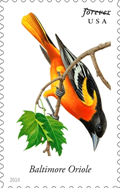
The Baltimore oriole was named for George Calvert, Lord Baltimore, a founder of the colony of Maryland, because the bird’s colors resemble those on Calvert’s coat of arms. Today, the oriole is Maryland’s state bird, as well as the namesake of Baltimore’s professional baseball team. A summer resident of the central and eastern United States, Baltimore orioles often nest in parks and backyards, where they are easily observed in tall, leafy trees.
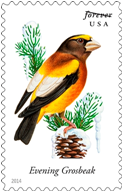
Although they breed in northern evergreen forests and western mountains, evening grosbeaks are most often seen in winter. With their thick, heavy bills, adapted to cracking the large seeds that make up most of their diet, these birds are easy to identify at birdfeeders. Roughly every second winter, evening grosbeaks migrate into parts of the country outside their normal range in search of food and can then be found scattered across many of the lower 48 states.

Common in eastern forests, the scarlet tanager is known as a long-distance migrant. Some travel from their summer habitat in Canada to winter habitats as far away as Peru, a trip of more than 4,000 miles. Although the males sport brilliant red body feathers and black wings while breeding, when winter comes, they resemble the female birds with dull greenish feathers.
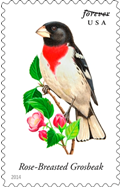
With his bold black-and-white feathers accented with a slash of red on the chest, the male rose-breasted grosbeak is a striking sight. Both sexes are known for their sweet, mellow and melodic singing voices. Male and female rose-breasted grosbeaks share the duties of incubating eggs and feeding chicks, and they sing to each other when changing places at their nest. Unusual among songbirds, they also sing while sitting on the nest.
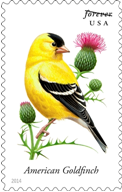
A beloved backyard bird that frequents bird-feeders, the American goldfinch can be found in all the lower 48 states at some point in the year. This acrobatic finch with its signature bouncy flight is easy to spot in open meadows, fields and parks as it forages for food. One of the strictest vegetarians in the bird world, the American goldfinch lives almost exclusively on seeds.

Breeding mostly in the forests of Canada, white-throated sparrows can be seen east of the Rocky Mountains and along the Pacific Coast during the winter. These sparrows are best located by looking at the ground, where they search under leaves for insects and seeds. White-throated sparrows also nest on or near the ground. Their striped heads are marked with a yellow patch between the eye and the beak, and bright white feathers at the throat give this bird its name.
Ordering First-Day-of-Issue Postmarks
Customers have 60 days to obtain the first-day-of-issue postmark by mail. They may purchase new stamps at local Post Offices, at usps.com/stampsor by calling 800-STAMP-24. They should affix the stamps to envelopes of their choice, address the envelopes to themselves or others and place them in larger envelopes addressed to:
Songbirds Stamp
Postmaster
401 Tom Landry Frwy, Room 645
Dallas, TX 75260-9998
After applying the first-day-of-issue postmark, the Postal Service will return the envelopes through the mail. There is no charge for the postmark up to a quantity of 50. For more than 50, there is a 5-cent charge per postmark. All orders must be postmarked by June 4, 2014.
Ordering First-Day Covers
The Postal Service also offers first-day covers for new stamp issues and Postal Service stationery items postmarked with the official first-day-of-issue cancellation. Each item has an individual catalog number and is offered in the quarterly USA Philatelic catalog online at usps.com/shop or by calling 800-STAMP-24 (800-782-6724). Customers may request a free catalog by calling 800-782-6724 or writing to:
U.S. Postal Service
Catalog Request
PO Box 219014
Kansas City, MO 64121-9014
Philatelic Products
Seven philatelic products are available:
689306, Press sheet with die cut, $78.40 (print quantity of 2,500)
689308, Press sheet without die cut, $78.40 (print quantity of 2,500)
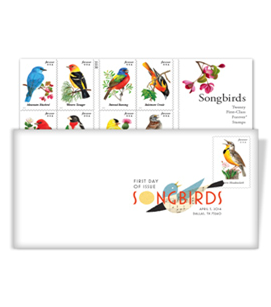
689310, Keepsake (booklet & random digital color postmark), $11.95
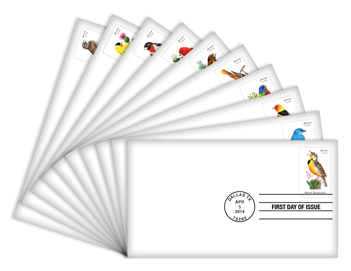
689316, First Day Covers (set of 10), $9.30<
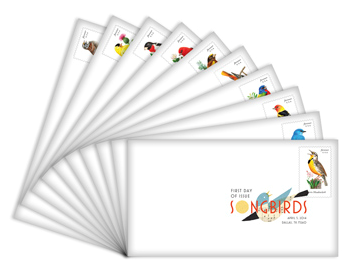
689321, Digital Color Postmarks (set of 10), $16.40
689331, Stamped Deck Card, $0.95
689232, Notecards (include 10 envelopes and stamps) $15.95
Customers may view the Songbirds Forever Stamps, as well as many of this year’s other stamps, on Facebook facebook.com/USPSStamps, Twitter@USPSstamps, Pinterest pinterest.com/uspsstamps, Instagram instagram.com/uspostalservice or on uspsstamps.com, the Postal Service’s online site for information on upcoming stamp subjects, first-day-of-issue events and other philatelic news.
###
Please Note: For broadcast quality video and audio, photo stills and other media resources, visit the USPS Newsroom at about.usps.com/news/welcome.htm.
For reporters interested in speaking with a regional Postal Service public relations professional, please go to about.usps.com/news/media-contacts/usps-local-media-contacts.pdf.
Follow us on twitter.com/USPS and like us at facebook.com/USPS. For more information about the Postal Service, go to usps.com and usps.com/postalfacts.

